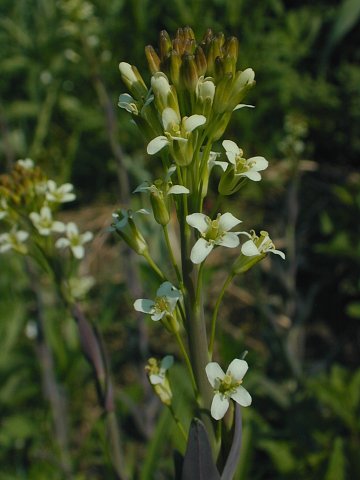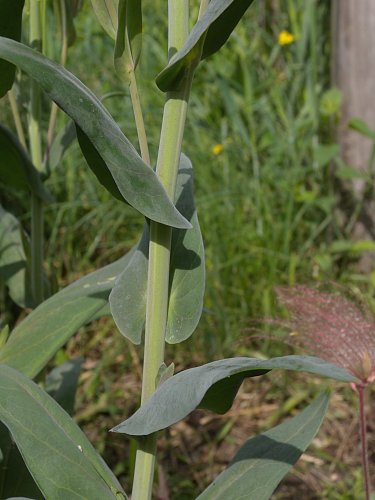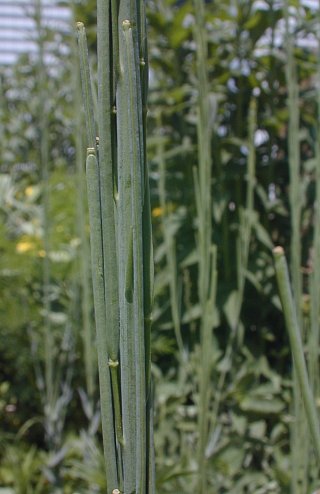Description: This biennial plant consists of a low-growing rosette of basal leaves up to 7" across during the 1st year. These basal leaves are up to 3½" long and ¾" across; they are green to greyish green, oblanceolate, dentate, and often slightly pinnatifid with shallow lobes. Their upper surface is often hairy, although they tend to become less hairy with age. During the 2nd year, Tower Mustard bolts during the spring and produces one or more flowering stalks up to 3½' tall. These stalks are light green to dull white, unbranched, hairless, and glaucous. Sometimes there may be a few hairs near the base of the stalks. The alternate cauline leaves are up to 3" long and 1" across. They are greyish green, lanceolate, smooth along the margins, hairless, and glaucous. Some of the lower cauline leaves may be dentate and slightly pinnatifid. The base of each cauline leaf clasps the stalk with a pair of basal lobes, which may be rounded or pointed. During cool spring weather, the cauline leaves may turn purple when they are exposed to full sun. Each stalk terminates in an elongated raceme of flowers and upright siliques (slender cylindrical seedpods). This raceme can become as long as the rest of the plant (up to 1¾' in length) and it has a tower-like appearance. Each flower at the apex of the raceme is up to 1/6" (4 mm.) across, consisting of 4 white or cream petals, 4 light green or yellow sepals, a stout style, and several stamens. The pedicels of the flowers and siliques are about ¼–½" in length.

The
blooming period occurs during late spring to mid-summer and lasts about
1½ months. Each flower is replaced by a slender cylindrical silique up
to 2½" long. The siliques are held upright close to stalk of the
raceme. Each silique contains 1 or 2 rows of slightly flattened ovoid
seeds. These small seeds have narrowly winged margins and they are
dispersed to some extent by the wind. The root system consists of a
stout taproot. This plant spreads by reseeding itself.
Cultivation:
The preference is full sun to light shade, mesic to dry conditions, and
loam, clay-loam, or rocky soil. This plant also tolerates soil
containing sand or hardpan clay. It is fairly easy to grow from seed.
Range & Habitat:
The native Tower Mustard occurs occasionally in the northern half of
Illinois, but
it is uncommon in the southern half of the state (see Distribution
Map). Habitats include various kinds of prairies (sand,
gravel, black soil, or clay), rocky open woodlands, barren savannas,
limestone glades, rocky bluffs, and abandoned fields. In Illinois,
Tower Mustard has low fidelity to any particular habitat. It also
occurs in Eurasia.

Faunal
Associations:
Mostly small bees and flower flies visit the flowers for nectar or
pollen. Occasionally various species of White butterflies (Pieridae)
visit the flowers for nectar. The caterpillars of two Pierid
butterflies, Anthocharis midea (Falcate Orangetip)
and Euchloe olympia (Olympia Marble), prefer Arabis
spp. (Rock Cresses) as a food source, particularly those Rock
Cresses that are typically found in sunny habitats. The caterpillars of
another Pierid butterfly, Pieris napi (Mustard
White), reportedly feed on Rock Cresses, although this butterfly
species hasn't been observed in Illinois since the 19th century. Little
information appears to be available about the desirability of Tower
Mustard as a food source for mammalian herbivores. However, the foliage
is not particularly bitter nor peppery.
Photographic Location:
The webmaster's wildflower garden in Urbana, Illinois.

Comments: Among the various Rock Cresses (Arabis spp. and related genera), Tower Mustard is mostly likely to be found in black soil prairies, although it also occurs in other kinds of habitats. The tower-like inflorescence gives this plant an odd appearance that is rather striking, especially when it becomes 3-4' tall. Because Tower Mustard is not difficult to grow and seems rather robust, it is rather surprising that this species is not more common. There are several Rock Cresses in Illinois, which can be found in either sunny or shady habitats, depending on the species. Some species have erect siliques that are appressed against the stalk of the raceme, while other species have siliques that are spreading or drooping. Tower Mustard belongs to the first group. Its appearance is similar to a very rare species, Arabis drummondii (Drummond's Rock Cress). This latter species has flattened siliques containing 2 rows of seeds and the style of its flowers is more slender than the style of Tower Mustard. Another species, Arabis hirsuta (Hairy Rock Cress), has hairs along at least the lower half of its flowering stalks, and it has flattened siliques containing a single row of seeds. The siliques of Tower Mustard are terete (round in cross-section). A scientific synonym of this plant is Arabis glabra.